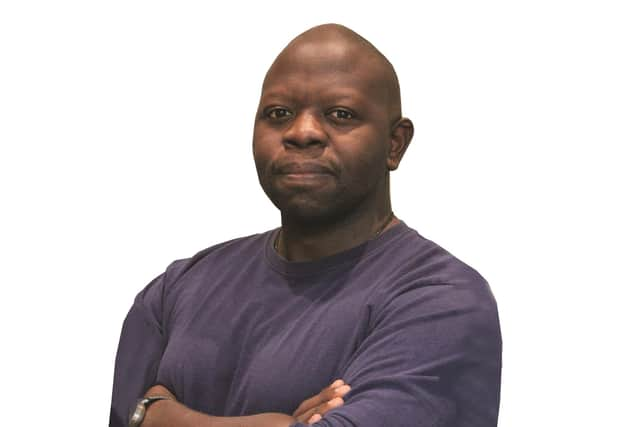Legal review: Bright moves on diversity
It was the culmination of a thorough year-long process which included an assessment of the Law Society’s commitment to equality, diversity and inclusion.
The results showed a colleague-friendly working environment from senior leaders – including the board – and a culture that accommodates personal circumstances, with flexible and hybrid-working arrangements valued, along with adjustments such as not holding meetings during lunchtime periods.
Advertisement
Hide AdAdvertisement
Hide AdAlthough the society is clearly dedicated to leading the way on equality and diversity, there is still plenty of work to be done across Scotland’s legal sector.


Diversity data gathered for the first time as part of the annual Practising Certificate renewal process for 2020-21 and published last year found that the Scottish legal profession is getting more ethnically diverse, although more slowly than the wider population.
It also noted that, despite about two-thirds of newly admitted members being female each year, there appears to be an issue attracting men from Black, Asian and minority ethnic (BAME) backgrounds.
Additionally, it is harder for those from lower socio-economic backgrounds to enter the sector.
“The profession is clearly and visibly a more diverse place than it was five or ten years ago,” says Rob Marrs, head of Education and Policy at the Law Society of Scotland.


“Anecdotally, we absolutely are becoming more diverse, which is great to see. However, there clearly are areas of the profession that need to improve.”
Marrs, who also heads up the society’s equality and diversity work, adds: “The external perception of the profession and what the profession actually is are two very different things. If you asked lots of people what they think is the average solicitor, they may well say a white male in his 50s when actually the biggest single group is state-educated women under the age of 40.
“Society perceptions take a long time to shift, but are there still barriers? Yes. Are they coming down? Yes. But there certainly is progress to be made.”
Advertisement
Hide AdAdvertisement
Hide AdBack in January, the society’s Racial Inclusion Group published a report that showed there is an increasingly diverse and progressive sector but one that is “hampered by slow progress, lack of visible minority role models and experiences of bias”.
Most worryingly, it found that 60 per cent of survey respondents have experienced bias, racism or discrimination on route to their qualification or during their careers.
“The most difficult and most essential change to the profession is that of creating an inclusive culture where everyone can thrive,” says Tatora Mukushi, convener of the Law Society of Scotland’s Racial Inclusion Group.
“This goes beyond politeness or adding Diwali and Kwanza to the celebratory calendar –we collectively need to reckon with the structural barriers that disproportionately face racialised people.
“In other words: confront institutional racism. Accept that it exists – and there is plenty of evidence that it does, alongside and in conjunction with other structural barriers, such as sex and class.”
Just over 3 per cent of the profession comes from a BAME background, with 88 per cent being white. Almost 7 per cent of those under the age of 30 now come from a BAME background.
Mukushi, who was appointed convener of the group when it began last year, says there needs to be an organising of the profession to tackle these issues: “The economics of the law often mimic racial lines, with ethnic minorities being often disproportionately involved in the less lucrative areas of the law – immigration, mental health, and the like.
“We need to bridge that gap to appreciate common purpose and common benefit in being a more inclusive profession.”
Advertisement
Hide AdAdvertisement
Hide AdHe also suggests confronting myths around meritocracy, highlighting that “throughout the legal profession, the most senior positions are held by disproportionately white practitioners and are skewed towards those who attended public schools”.
But there has been a slight improvement in recent years on the number of solicitors attending state schools, with more than two-thirds now having done so. And in terms of gaining access, Marrs points to the Law Society’s Lawscot Foundation, which offers aspiring solicitors from less-advantaged backgrounds bursaries of £2,500 during their studies.
In August, it announced a new sponsorship deal with the Clark Foundation for Legal Education, which has committed £12,500 to the foundation over the next three years. This latest pledge from the foundation will be enough to cover all bursary payments for three students during five years of their studies.
“The biggest thing over the last few years is the society establishing the Lawscot Foundation which funds every year a number of people through the LLB, but also includes linking up with mentors in the profession,” says Marrs.
“Earlier this month, we hosted an event where one of the first people we funded [through the foundation] spoke and he is now a trainee solicitor. That was why we set it up and it is really lovely to see it happening.”
But when it comes to inspiring the next generation of ethnic minority law students, the Racial Inclusion Group’s report clearly suggests that employers want diverse talent, but struggle to attract it.
That is in part due to a gap between the number of ethnic minority law students and those applying successfully to the largest employers of trainees in Scotland.
Mukushi says: “The report describes the dismay that many members have felt at not seeing themselves reflected in the senior ranks of lawyers in Scotland.
Advertisement
Hide AdAdvertisement
Hide Ad“It also relates the very practical difficulties of securing work experience, not having family or friends in the law, and having competing priorities.
“Firms should be looking at the figures of ethnic minority students in schools and universities, and going to where they are to recruit, encourage and learn from them what it is that they need to be recruited.”
The Law Society of Scotland is working to improve this and has carried out several events this year alone to spotlight diversity and inclusion.
Mukushi comments: “The Law Society has facilitated and promoted the work of groups like Fairer Justice System Scotland, Black Professionals Scotland and Scottish Ethnic Minorities Lawyers Association, all grassroots organisations working to increase the opportunities for ethnic minorities to work in the sector.”
Similarly, Marrs highlights a blossoming of organisations in the profession that have added to the diversity of the sector, which includes the Glass Network – an organisation working to increase visibility of LGBTQ+ role models in the legal profession.
More than 3 per cent of the sector is LGBTQ+, according to the most recent diversity data, but more than 10 per cent of respondents selected “prefer not to say” when surveyed, which is 3 per cent more than those choosing the same option when answering on ethnicity.
And change looks set to continue with the real shift so far being mindset-based, according to Marrs. He concludes: “Until relatively recently, equality, diversity and inclusion was viewed almost as compliance. Over the last few years, we have seen a mindset shift to move beyond compliance and really embrace the concept to say, ‘If we get this right our people will be more diverse, happier, more productive and we have happier clients’.
“Everything flows from all of those things.”